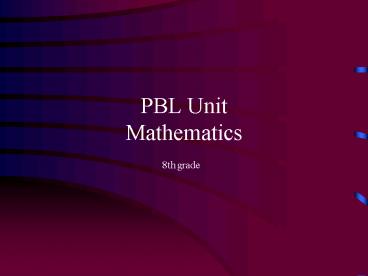PBL Unit Mathematics - PowerPoint PPT Presentation
1 / 8
Title:
PBL Unit Mathematics
Description:
... introduced by discussing the New York mosquito problem. Procedure: ... Have each group to read and discuss an article on N.Y. mosquito problem among themselves. ... – PowerPoint PPT presentation
Number of Views:123
Avg rating:3.0/5.0
Title: PBL Unit Mathematics
1
PBL UnitMathematics
- 8th grade
2
Lesson Plans Follow
Note These can take different amounts of time.
They can be used for a one day lesson or a weeks
lesson its up to you.
3
Lesson 1 Qcc Objectives Describe
orally and in writing, using the appropriate
mathematics vocabulary, mathematical concepts and
procedures such as solving a word problem
or computing. Selects and uses appropriate
customary and metric units of measure for
length. Convert from one metric unit to
another metric unit and from one customary unit
to another. Selects and uses appropriate
problem solving strategies to solve single and
multi step problems. Solves practical
problem using percents. Lesson Objectives
Students will be able to solve problems using
addition, subtraction, multiplication, and
division to solve problems. Learner Outcomes
Students will be able to solve problems when they
are provided with adequate information. Assessment
Students will create two multi-step word
problems and solution. One problem should be
turned in to the teacher and the other will be
explained by the student to the
class. Introduction The lesson will be
introduced by discussing the New York mosquito
problem.
4
Procedure Go over arithmetic skills
that students may be having trouble with.
Put students in group of four. Have each
group to read and discuss an article on N.Y.
mosquito problem among themselves. Have
each group to present their article. Pull
out information from these articles to create
word problems. Each group will work out
the word problems. Each group will create
their own multi-step problem and a solution.
Distribute these problems around the class and
have each student in each group to complete a
different problem. Assessment. Closure Cla
ss will discuss why this is important in
life. Materials Newspaper and magazine articles
5
Lesson 2 Uses computer software and
applications to research, investigate, and
analyze data using charts, tables graphs, or
other presentation forms. Collects and
organizes data, determines appropriate method and
scale to display data, and constructs frequency
distributions bar, line, and circle
graphs tables and charts line plots, stem and
leaf plots, box and whiskers plots, and scatter
plots. Reads, interprets, compares, and
analyzes data in frequency distributions,
diagrams, charts, tables, graphs, and makes
predictions or draws conclusions based on
data. Lesson Objectives Students will be
able to Identify different types of
graphs. Determine which type of graph will
display data appropriately. Analyze and
give an oral or written description of a graph
using mathematical vocabulary. Learner Outcome
Students will know how to read graphs and
draw conclusions about lists of
data. Assessments Students will be given
data to determine which graph will give the best
representation of the data. They will graph this
data and give an oral presentation analyzing the
data. Introduction Lesson will be
introduced by reviewing the New York mosquito
problem.
6
Procedure Go over necessary vocabulary.
Go over types of graphs and data that is
best represented on each. Put students
into groups of four. Discuss things about
the N.Y. mosquito problem that would be
interesting to graph. Data can also come
from problem solving lesson. Allow
students to decide on the data that should be
graphed. Students should interact in
conversation to determine which graph will best
display each set of data. Graph and
analyze several sets of data.
Assessment Closure Have students to
discuss ways these skills will help them in the
future.
7
Qcc Objective Describe orally and in
writing, using mathematical vocabulary, concepts,
and procedures such as solving a word problem or
computing. Selects and uses appropriate
customary and metric units of measure for
length. Converts from one metric unit to
another. Selects and uses appropriate
problem-solving strategies to solve single and
multi-step problems. Solves practical
problems using percents. Collects and
organizes data determines appropriate method and
scales to display data. Reads, interprets,
compares, and analyzes data in frequency data.
Lesson Objective Students will be able to
determine which information is valid for
graphing. Students will be able to analyze data
using mathematical terms and everyday terms.
Students will be able to solve single and
multi-step problems. Learner outcome Students
will understand how basic graphing skills and
problem solving skills will clarify information
for individuals. Assessment Student will
participate in a forum. They will be expected to
display graphs and give information about costs
of different techniques for controlling mosquito
population. Introduction The team will be
brought together in the auditorium. The mayor
will introduce the problem to the
team. Procedure Help students determine
if information is of importance to situation.
8
Procedure Help students determine if
information is of importance to situation.
Go over graphs and mathematical
information to make sure students have accurate
data. Guide students to have all
mathematical data possible.
Assessment. Closure Students will participate
in a classroom discussion concerning what they
liked, disliked, and things the learned.































